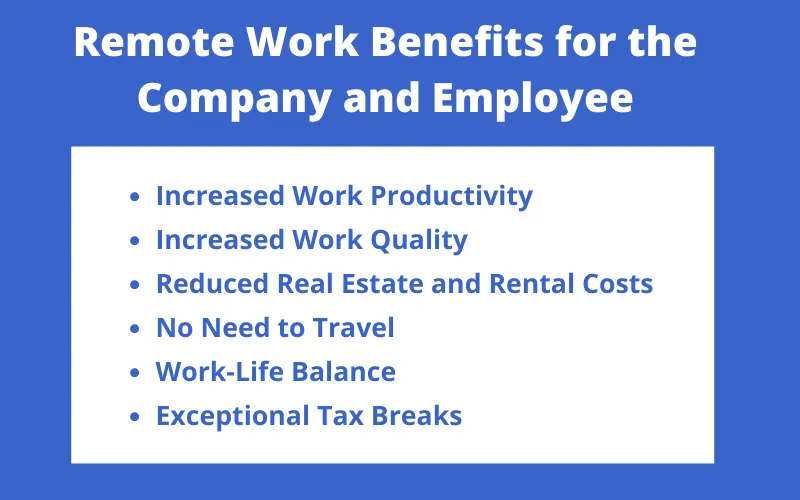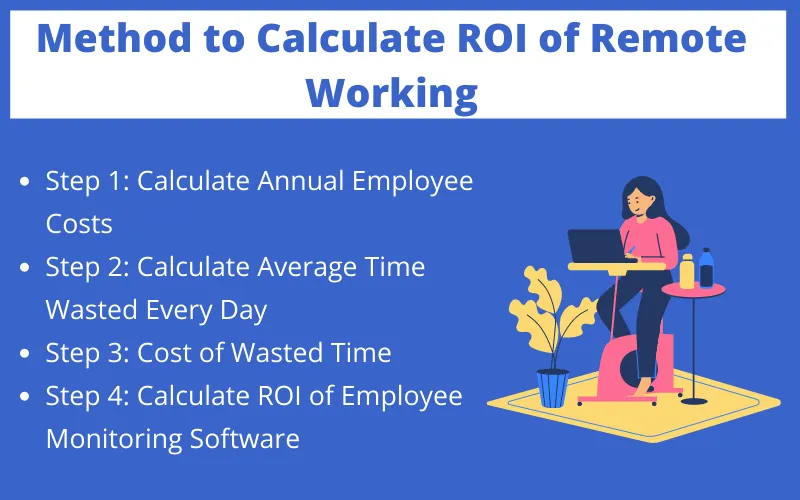How to Calculate ROI of Remote Working
How to Calculate ROI of Remote Working
You can enhance your organizational productivity by evaluating the ROI of remote working. You can clearly understand your business status with a remote workplace ROI and make informed decisions.
By removing barriers to employee productivity, maximizing customer satisfaction, and maximizing employee engagement, a business can meet its greater business needs.
ROI of Remote Working: What is it?
Return on investment is an important measure for evaluating the success of any venture and planning its future growth.
While measuring analytical things like social media followers might seem easy, measuring the actual outcome isn’t a straight road.
The best place to start is to identify the business reasons for introducing a certain collaboration platform, followed by examining the team’s objectives and current state to estimate the ROI of remote working.
An incorrect definition of ROI can lead to poor performance. Understanding your business goals and the current situation is important before deciding on your digital workplace.
Remote Work Benefits for the Company and Employee

Remote Work Benefits for the Company
As an organization considers remote work benefits and ROI, it must consider quantifiable numbers and data and qualitative, anecdotal information equally valuable.
Some metrics are easily retrievable in a report, but others must be gleaned from staff-wide surveys or conversations with employees.
Increased Work Productivity
We have seen increased productivity as a major benefit of remote work when teams work from home or another location.
This increase is because managers and remote workers work together, with different schedules that suit the worker better, optimizing their work time and energy.
Rather than a more rigid work schedule, managers and workers can customize and support the most effective work schedules, helping employees focus on the work and tasks that matter most and have the most impact.
Aside from this, some tools automate tasks, giving you more time for priorities.
Increased Work Quality
Increasing productivity also means improving work quality since employees work in more suitable conditions to their needs.
It’s not surprising that many people who work from home have reported improved work-life balance and improved relationships with colleagues.
Reduced Real Estate and Rental Costs
It is relatively easy to calculate the ROI of remote working from reducing office rent and office space costs. Employees do not need to purchase or rent a costly building due to the lack of a physical office.
Organizations can save significant money on supplies and maintenance and the monthly costs of running an office.
Even though supplies are needed in a home office, a significant budget is saved since there is no need to pay rent.
Remote Work Benefits for the Employee
No Need to Travel
Everyone doesn’t have a personal vehicle, and workplaces aren’t always near employees’ residences.
The commute is one of the biggest complaints of many employees, and remote working solves this issue of traveling to your workplace.
It can be hard for employees to travel from home to workplace, wait in jams, and return from work. They feel like traveling results in a waste of their precious time.
Also, commuting daily and challenges while commuting can cause stress.
Due to the absence of daily stress and challenges of the commute, remote working can improve the employee’s mental health.
The additional benefits may include significant savings (travel fees) and a reduction in the likelihood of accidents.
Work-Life Balance
Work and life balance is important for most people, and remote workers often have it. Balancing work and personal life cannot be easy as our lives change.
It is, however, generally easier to maintain equilibrium in a remote and teleworking environment, even if working from home can be more revealing.
By making team members take regular breaks, allowing them to work remotely, and promoting physical activity, you can find a work-life balance.
Separating work and personal life is imperative when working from home. When working from home, you can maintain a separate work area, make a schedule, take frequent breaks, and save money by eating at home.
Exceptional Tax Breaks
During this pandemic, saving from the tax breaks of working from home has become more prominent. You can claim many remote work expenses during tax season if you know which tax breaks you can claim.
You can claim anything, including electricity and gas, internet, cell phone, and mortgage payments, that goes along with your home as your place of work. These things can include computers, printers, and paper.
Taxation can all be quite complicated, so we recommend that you hire a professional accountant to help you file your taxes and expenses to get the greatest return on your home office costs.
4 Step Method to Calculate ROI of Remote Working

To calculate ROI, subtract the initial investment value from the final investment value. By dividing ROI by investment cost and multiplying by 100, you’ll get the ROI.
However, calculating the ROI of remote working can be difficult. We can help you find insights that show how your remote team is performing and how it can improve several key areas of your operations.
Let me show you how to calculate the ROI of remote working in four easy steps.
Step 1: Calculate Annual Employee Costs
The first step is to calculate the annual cost of your employees. Have you calculated your annual cost on employees yet? Okay, let’s move on to another step.
Step 2: Calculate Average Time Wasted Every Day
Employees are not 100% efficient. Even the best working employees waste extra activities like social media, long breaks, private calls, or entertainment.
Your employees waste 2 in 9 hours of their daily working hours on external factors. They waste a quarter of working hours every day.
Step 3: Cost of Wasted Time
This step calculated the expense when your employees were not productive. You calculate the average percentage of workday wasted and multiply it by the individual employee’s cost.
You can reduce wasted time by using employee monitoring software. When your employees know that you are monitoring them, they will not spend their work hours doing something unproductive.
Step 4: Calculate ROI of Employee Monitoring Software
Now, you can calculate the savings by using employee monitoring software. And finally, you can calculate ROI by dividing the savings due to the software divided by the cost of employee software.
Using employee monitoring software, you can calculate the ROI of remote working.
Metrics that Assist in Measuring ROI (Return on Investment)
Less Infrastructural Costs
Traditional offices required substantial fixed capital investment to rent offices and buy other essentials needed. When an office is remote-based, the company can save on labor costs.
You can apply these savings to other processes that have a significant budget. Small work businesses can evaluate the ROI of remote working by comparing capital and operational expenses early in the process and the cost of digital workplace technology hardware and software subscriptions.
A positive difference in remote costs indicates remote workplace success.
Those Who Influence
Some users adapt to every platform faster than others. These users can serve as influencers who catch the attention of others in their workplace.
Using their skills and enthusiasm to entice more employees to use your digital workplace can be a key factor for ROI.
Sales and Customer Relations
Every organization strives for customer conversions. To deliver a great customer experience and motivate sales, your Salesforce must develop a digital workplace capable of closing top deals by making sure all information is readily available.
Your sales team should access any information immediately. Do you have any success stories regarding remote work? You can also include this under ROI Works.
Conclusion
Employers need to realize that remote working offers some benefits that show their effects over time, despite the importance of measuring the ROI of remote working.
A company can use a specific set of metrics to evaluate remote workplace productivity. When combined with digital transformation, this method will deliver excellent results.

 in Melbourne
in Melbourne 
 Employee Screen Monitoring Software
Employee Screen Monitoring Software App and Website Monitoring Software
App and Website Monitoring Software Time and Attendance Software
Time and Attendance Software Finance
Finance Banking
Banking Healthcare
Healthcare Lawyers
Lawyers Retail & ecommerce
Retail & ecommerce Knowledge base
Knowledge base Blogs
Blogs Installation Guide
Installation Guide FAQs
FAQs About
About Media Kit
Media Kit Contact us
Contact us